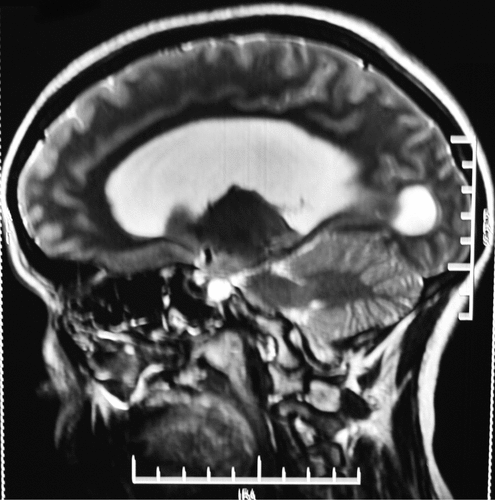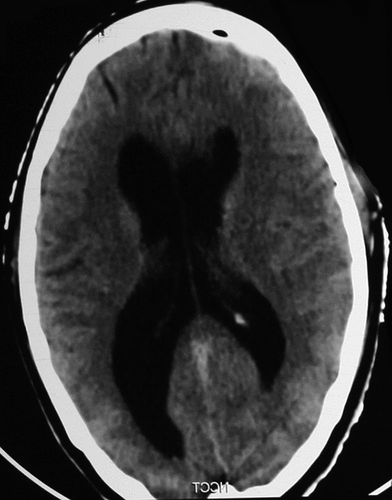Colloid Cyst Presenting as Recurrent Mania
To the Editor: A colloid cyst, also called a neuroepithelial cyst, is a slow-growing, benign tumor that occurs in the anterior third ventricle.1 Colloid cysts of the third ventricle represent 0.5%−2% of all intracranial tumors.2,3 The cyst typically blocks the foramen of Monro, causing obstructive hydrocephalus involving only the lateral ventricles. The common presenting symptoms are headache, nausea, vomiting, memory loss, mental status changes, gait disorder, insomnia, and visual disturbances.4 We report a case who presented with organic manic disorder, which remitted after the surgery.
“Ms. N,” a 24-year-old, married woman presently working as a housewife, was referred from the neurosurgery ward to the Psychiatry outpatient department with chief complaints of abnormal behavior, seeing pictures/images of some man and animals, and feeling sensations as if someone is touching her for few seconds. The patient was apparently well 15 days ago, when she stopped taking care of her 10-month-old child, and mixed salt in the milk to be given to the child. She cleaned the house and then spread the dirt again. Also, in many instances, she would put clothes in to wash and then to dry without ever cleaning them. She had also been watching images of one man who was changing his body form into a lion that kept changing in size. Many times, she also saw something like an animal standing at the door of her house and trying to come inside her room. For the last 2 weeks, her mood had become highly elated. At times, she was spending money beyond her budget and developed features of overactivity, excessive talking, argumentativeness, extreme irritability, grandiosity, abusiveness, and decreased need for sleep. There was an increase in her appetite and decrease in sleep. Occasionally, she also felt restlessness and anxiety. There were no first-rank symptoms suggestive of schizophrenia. She had similar symptoms twice in the past, about 3 years and 6 years ago, with each lasting for about 15 days, without any treatment. Her personal and family history was noncontributory. CT scan showed a colloidal cyst in the brain, with obstructive hydrocephalus (Figure 1). She was started on haloperidol 10 mg/day and divalproex sodium 1,000 mg/day. She was operated on (Figure 2), after which there was remission of psychotic symptoms. Medication was discontinued after 3 months. On following her up for the last 6 months, she has not developed any symptoms. Surgical resection is the recommended treatment,2,5 as was done in the present case. After the surgery, there was remission of neuropsychiatric symptoms. This is the first case report of colloid cyst presenting with recurrent manic symptoms.


1 : Colloid cyst: a case study. J Neurosurg Sci 2007; 51:53–60Medline, Google Scholar
2 : Endoscopic treatment of colloid cyst of third ventricle: long-term results in a series of 6 consecutive cases. Minim Invasive Neurosurg 2007; 50:313–317Crossref, Medline, Google Scholar
3 : Colloid cyst of the third ventricle. J Neurol Neurosurg Psychiatry 2002; 72(Suppl 2):ii15Medline, Google Scholar
4 : Neuropsychiatric manifestations of a third-ventricular colloid cyst. Am J Forensic Med Pathol 1980; 1:29–45Crossref, Medline, Google Scholar
5 : Colloid cysts of the third ventricle: endoscopic and open microsurgical management. Neurol Neurochir Pol 2009; 43:251–257Medline, Google Scholar



